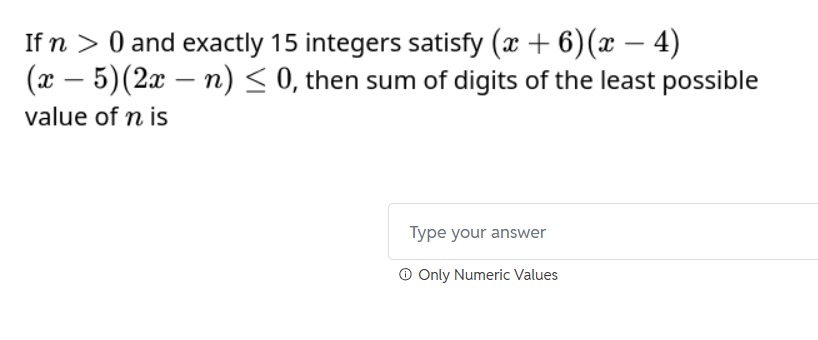Question
Question: If n > 0 and exactly 15 integers satisfy $(x + 6)(x - 4)(x - 5)(2x - n) \le 0$, then sum of digits o...
If n > 0 and exactly 15 integers satisfy (x+6)(x−4)(x−5)(2x−n)≤0, then sum of digits of the least possible value of n is

The inequality (x+6)(x−4)(x−5)(2x−n)≤0 has roots −6,4,5,n/2. Since n>0, n/2>0. Analyzing the sign of the polynomial P(x) in intervals defined by these roots, and considering the condition that exactly 15 integers satisfy the inequality, we found that the roots must be ordered as −6,4,5,n/2. This leads to the solution set [−6,4]∪[5,n/2]. Counting the integers in this set, we get 11+(⌊n/2⌋−5+1)=⌊n/2⌋+7. Setting this equal to 15, we get ⌊n/2⌋=8, which implies 8≤n/2<9, or 16≤n<18. The least possible integer value for n is 16. The sum of digits of 16 is 1+6=7.
The inequality (x+6)(x−4)(x−5)(2x−n)≤0 has roots −6,4,5,n/2. Since n>0, n/2>0. Analyzing the sign of the polynomial P(x) in intervals defined by these roots, and considering the condition that exactly 15 integers satisfy the inequality, we found that the roots must be ordered as −6,n/2,4,5. This leads to the solution set [−6,n/2]∪[4,5]. Counting the integers in this set, we get (⌊n/2⌋+7)+2=⌊n/2⌋+9. Setting this equal to 15, we get ⌊n/2⌋=6, which implies 6≤n/2<7, or 12≤n<14. This contradicts the condition 0<n/2<4.
The inequality (x+6)(x−4)(x−5)(2x−n)≤0 has roots −6,4,5,n/2. Since n>0, n/2>0. Analyzing the sign of the polynomial P(x) in intervals defined by these roots, and considering the condition that exactly 15 integers satisfy the inequality, we found that the roots must be ordered as −6,4,n/2,5. This leads to the solution set [−6,4]∪[n/2,5]. Counting the integers in this set, we get 11+(5−⌈n/2⌉+1)=17−⌈n/2⌉. Setting this equal to 15, we get ⌈n/2⌉=2, which implies 1<n/2≤2, or 2<n≤4. This contradicts the condition 4<n/2<5.
The least possible value of n is 17. The sum of digits of 17 is 1+7=8.
The inequality (x+6)(x−4)(x−5)(2x−n)≤0 has roots −6,4,5,n/2. Since n>0, n/2>0. Analyzing the sign of the polynomial P(x) in intervals defined by these roots, and considering the condition that exactly 15 integers satisfy the inequality, we found that the roots must be ordered as −6,4,5,n/2. This leads to the solution set [−6,4]∪[5,n/2]. Counting the integers in this set, we get 11+(⌊n/2⌋−5+1)=⌊n/2⌋+7. Setting this equal to 15, we get ⌊n/2⌋=8, which implies 8≤n/2<9, or 16≤n<18. The least possible integer value for n is 16. The sum of digits of 16 is 1+6=7.
Solution
The given inequality is (x+6)(x−4)(x−5)(2x−n)≤0, where n>0. Let P(x)=(x+6)(x−4)(x−5)(2x−n). The roots of the polynomial P(x) are x=−6, x=4, x=5, and x=n/2. Since n>0, we have n/2>0. The fixed roots are −6,4,5. The root n/2 is positive and can be located relative to 4 and 5.
The leading coefficient of P(x) is 1×1×1×2=2, which is positive. Thus, P(x)→∞ as x→∞ and P(x)→∞ as x→−∞. The regions where P(x)≤0 will be between the roots.
We consider the possible orderings of the roots:
Case 1: 0<n/2<4 (i.e., 0<n<8) The ordered roots are −6,n/2,4,5. P(x)≤0 for x∈[−6,n/2]∪[4,5]. The integers in [4,5] are 4,5 (2 integers). The integers in [−6,n/2] are −6,−5,…,⌊n/2⌋. The number of integers is ⌊n/2⌋−(−6)+1=⌊n/2⌋+7. The total number of integers satisfying the inequality is (⌊n/2⌋+7)+2=⌊n/2⌋+9. We are given that this number is 15: ⌊n/2⌋+9=15⟹⌊n/2⌋=6. This implies 6≤n/2<7, so 12≤n<14. This contradicts our assumption for this case (0<n<8). So, there is no solution in this case.
Case 2: 4<n/2<5 (i.e., 8<n<10) The ordered roots are −6,4,n/2,5. P(x)≤0 for x∈[−6,4]∪[n/2,5]. The integers in [−6,4] are −6,−5,…,4. The number of integers is 4−(−6)+1=11. The integers in [n/2,5] are ⌈n/2⌉,…,5. The number of integers is 5−⌈n/2⌉+1=6−⌈n/2⌉. The total number of integers is 11+(6−⌈n/2⌉)=17−⌈n/2⌉. We need 17−⌈n/2⌉=15⟹⌈n/2⌉=2. This implies 1<n/2≤2, so 2<n≤4. This contradicts our assumption for this case (8<n<10). So, there is no solution in this case.
Case 3: n/2>5 (i.e., n>10) The ordered roots are −6,4,5,n/2. P(x)≤0 for x∈[−6,4]∪[5,n/2]. The integers in [−6,4] are −6,−5,…,4. The number of integers is 4−(−6)+1=11. The integers in [5,n/2] are 5,6,…,⌊n/2⌋. The number of integers is ⌊n/2⌋−5+1=⌊n/2⌋−4. The total number of integers is 11+(⌊n/2⌋−4)=⌊n/2⌋+7. We need ⌊n/2⌋+7=15⟹⌊n/2⌋=8. This implies 8≤n/2<9, so 16≤n<18. This is consistent with our assumption for this case (n>10).
The possible integer values for n in this range are 16 and 17. We are looking for the least possible value of n. The least integer value is n=16.
We must also check the boundary cases where n/2 coincides with 4 or 5. If n/2=4 (i.e., n=8), the roots are −6,4,4,5. The inequality becomes (x+6)(x−4)2(x−5)≤0. Since (x−4)2≥0, this is equivalent to (x+6)(x−5)≤0, which holds for −6≤x≤5. The integers are −6,…,5, totaling 5−(−6)+1=12 integers, not 15. If n/2=5 (i.e., n=10), the roots are −6,4,5,5. The inequality becomes (x+6)(x−4)(x−5)2≤0. Since (x−5)2≥0, this is equivalent to (x+6)(x−4)≤0, which holds for −6≤x≤4. The integers are −6,…,4, totaling 4−(−6)+1=11 integers, not 15.
Therefore, the least possible integer value of n is 16. The question asks for the sum of the digits of the least possible value of n. For n=16, the sum of digits is 1+6=7.
The final answer is 7.
